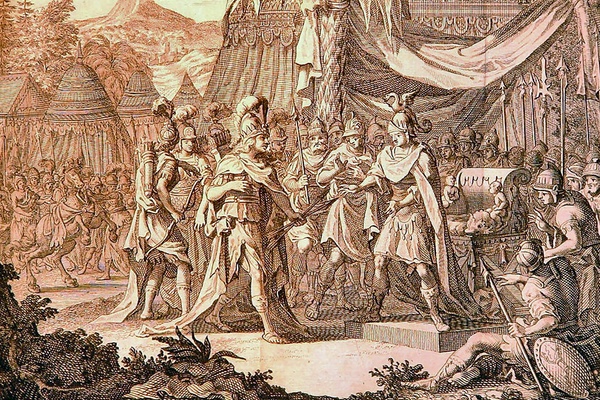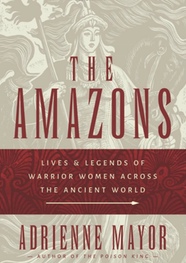Ancient Amazons -- Imaginary, Man-Hating Virgins Invented to Be Killed by Greek Heroes? Wrong.

Thalestris, Queen of the Amazons, visits Alexander (1696)
The
most notorious "fact" that almost everyone has heard about
Amazons is based on zero evidence. The idea that the warrior women
sacrificed a breast in order to draw a bow is illogical, as any archer or fan of "The Hunger Games" knows. The claim was rejected in classical
antiquity by writers and artists--yet this hoary barnacle of false
information has not budged for more than 2,500 years. The fascinating
origins and tenacity of this belief warrant an entire chapter's
discussion (see chapter 5 of my new book, The
Amazons).
But single-breastedness is only one of many misunderstandings
perpetuated about the fierce warrior women of myth and
history. Another
stubborn image of Amazons pictures a tribe of man-hating virgins. The
notion that Amazons were committed to lifelong chastity and were
hostile to men might have arisen from comparisons with the virginal
Greek goddesses of war and hunting, Athena and Artemis. The Greek
playwright Aeschylus (fifth century BC) described Amazons as “maidens
fearless in battle.” Maiden is often conflated with virgin today,
but it simply meant “unmarried” in antiquity.
Another
stubborn image of Amazons pictures a tribe of man-hating virgins. The
notion that Amazons were committed to lifelong chastity and were
hostile to men might have arisen from comparisons with the virginal
Greek goddesses of war and hunting, Athena and Artemis. The Greek
playwright Aeschylus (fifth century BC) described Amazons as “maidens
fearless in battle.” Maiden is often conflated with virgin today,
but it simply meant “unmarried” in antiquity.
“Man-killers”
was another ancient label for Amazons. The Greek historian Herodotus
(ca 450 BC) remarked that real-life Amazons of the Scythian steppes
did not "marry" unless they had slain a man in battle.
Among nomadic tribes of horse people on the vast steppes of Eurasia,
where everyone rode, hunted, and made war, it made sense for young
women and men to prove their mettle before forming couples and
mating. Herodotus commented that a few women never married. But these
customs did not mean that unproven warrior-girls and single women
were technically virgins. Herodotus and other ancient authors
describe plenty of Amazon sex with men outside of traditional
marriage as understood by the Greeks.
The
persistent idea that Amazons were hostile toward all men was
contradicted in antiquity. Hellanikos, a contemporary of Herodotus,
described Amazons as “man-loving." Far from preserving
virginity, Amazons were said to be lusty lovers of men of their own
choosing. Ancient writers identified Amazons as self-confident women
of the steppe cultures who fought for glory and survival and enjoyed
male companionship, but on independent terms that seemed
extraordinary to the Greeks. Numerous ancient accounts describe the
Amazons as controlling their own sexuality and reproduction in
companionate relationships based on equality.
A
strong bond of sisterhood was another famous Amazon trait in
classical art and literature. This is often interpreted as a sexual
preference for women by modern commentators. But the identification
of lesbians with Amazons is a twentieth century twist, declared by
the Russian poet Marina Tsvetaeva (b. 1892), Natalie Clifford Barney
(Pensées d'une Amazone, 1920), and Ti-Grace Atkinson (Amazon
Odyssey, 1974). The Greeks were forthcoming about male and female
homosexuality, yet no surviving writer mentions homosexuality among
Amazons. That does not preclude such relationships among the
historical counterparts of the Amazons of the steppes, of course--and
a unique painting on an ancient Greek vase imagines that option. The
artist illustrated a courting scene between a Thracian huntress and
the great Amazon queen Penthesilea who fought in the legendary Trojan
War.
Other
convincing evidence from antiquity confirms that Amazons were
perceived as sexually active: More than 130 personal names of Amazons
were recorded in classical literature and art. Only 3 of those named
Amazons—Alkippe, Sinope, and Orithyia—were singled out as
extraordinary because of their vows of virginity. Verdict: Amazons
were man-killers on the battlefield but not man-hating
virgins.
Archaeological
discoveries of the graves of hundreds of battle-scarred female
skeletons buried with weapons now confirm the reality of women known
as Amazons. Yet many still believe that the Greek imagination alone
summoned Amazons into existence just so they could be killed off by
Greek heroes. Amazons only existed in myth to be defeated, goes the
argument, and heroic warrior status is impossible for women. True,
Amazons are always killed by Greek heroes in myths. But more
significantly, the women are the men's equals in valor and prowess.
Every Amazon warrior is as brave and noble as the hero she duels.
Greek vase paintings of the battles with Amazons are filled with
suspense; Amazons fight and die courageously and some even kill Greek
warriors. Combat with an Amazon foe requires a fair match, or there
is no honor for the ultimate Greek victor.
Die
young and beautiful. Amazons invariably do. But a brief, splendid
life and death in battle was the ideal heroic destiny: every Greek
hero craved “imperishable glory." The heroic spirit proclaims
“If our lives be short, let our fame be great.” Remarkably, in
Greek myths and historical accounts, Amazons consistently display
that valiant spirit, dying heroically in battle. No Amazon ever died
old.
In
fact, Amazons actually surpass the Greek mythic heroes in the manner
of their deaths. Despite their vaunted courage and might, not one of
the greatest Greek heroes achieves a glorious death on the
battlefield. Perseus, the slayer of Medusa? Died naturally at a ripe
old age. Odysseus? Accidentally stabbed by his own son. Bellerophon?
Thrown by his flying horse Pegasus into a thorn bush, ends up blind
and lame. The superhero Heracles? Pathetic death by poisoned tunic, a
gift from his wife. Theseus, Athens’ founding hero? Shoved off a
cliff by an elderly king. The mighty Achilles? Ingloriously cut down
by an arrow in the heel, shot from behind. Jason, leader of the
Argonauts? Crushed by a rotting beam from his old ship the
Argo.
Amazons
were heroines from exotic lands, evoking awe and respect. The
praiseworthy heroic status of the Amazons is at odds with seeing them
as victims in some tragedy of ancient misogyny. Instead, the Amazons
of myth represented worthy human adversaries for mortal Greek heroes.
Amazons had desires, virtues, hopes, flaws, and vulnerabilities like
those of Greek heroes. Moreover, like the greatest Greek male
champion, each Amazon queen was the protagonist of her own mythic
biography, with multiple alternate versions.
It
is commonly taken for granted that Amazons were the exclusive
creative property of the ancient Greeks alone. But this
Hellenocentric assumption also turns out to be false, disproved by
literary, historical, artistic, linguistic, and archaeological
evidence for traditions of Amazon-like women across many other
ancient cultures, much of it only coming to light recently.
So
the Greeks did not invent Amazons. But there is a stark difference
between the Greek mythic script and other ancient Amazon traditions.
In the Greek myths, heroes always destroy Amazons. But in the tales
told by non-Greek cultures that actually met female horse-archers on
the battlefield, more realistic scenarios unfold. The warlike women
forge alliances and friendships with former foes, they fall in love,
they win victories, suffer defeats, and live to fight again. In the
Greek Amazon myths that have come down to us, Amazons are doomed. But
outside Greek mythology—and beyond the Greek world—women warriors
and male warriors might make love and war together as equals—and
even live happily ever after.